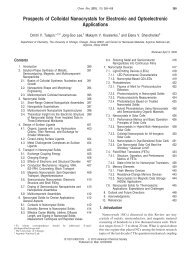Sharing the Cost of Backbone Networks - Computer Science
Sharing the Cost of Backbone Networks - Computer Science
Sharing the Cost of Backbone Networks - Computer Science
You also want an ePaper? Increase the reach of your titles
YUMPU automatically turns print PDFs into web optimized ePapers that Google loves.
5<br />
(a) In case <strong>of</strong> a link located in <strong>the</strong> USA.<br />
(b) Aggregated relative costs <strong>of</strong> top 10 customers<br />
in case <strong>of</strong> diverse link expenditures. and 95th percentile–customer<br />
(c) Ratio <strong>of</strong> <strong>the</strong> costs <strong>of</strong> <strong>the</strong> 95th percentile–device<br />
policies<br />
Fig. 3.<br />
Discrepancies between <strong>the</strong> cost sharing policies.<br />
(a) Volume–device policy (b) Customer peak–device policy (c) 95th percentile–device policy (d) Aggregate peak–device policy<br />
Fig. 4.<br />
Discrepancies between <strong>the</strong> cost sharing policies and <strong>the</strong> Shapley costs; distribution <strong>of</strong> <strong>the</strong>ir ratios<br />
(a) Volume–device policy<br />
(b) Aggregate peak–device policy<br />
Fig. 5. Traffic pattern <strong>of</strong> single customers with <strong>the</strong> largest maximal<br />
discrepancies given non-negligible traffic volumes<br />
tomer causes a high cost for <strong>the</strong> given link (figure not shown).<br />
Despite <strong>the</strong> customer’s modest aggregate volume, <strong>the</strong>se peaks<br />
result in <strong>the</strong> large discrepancy <strong>of</strong> this policy, whereas <strong>the</strong> real<br />
marginal contribution <strong>of</strong> <strong>the</strong> customer to <strong>the</strong> overall cost <strong>of</strong><br />
<strong>the</strong> device is limited.<br />
95th percentile–device policy: Thecustomerhason<strong>the</strong>one<br />
hand non-negligible 95th percentile traffic while on <strong>the</strong> o<strong>the</strong>r<br />
hand it barely contributes to <strong>the</strong> real cost <strong>of</strong> <strong>the</strong> link (figure<br />
not shown).<br />
Aggregate peak–device policy: The customer is almost exclusively<br />
responsible for <strong>the</strong> peak utilization <strong>of</strong> <strong>the</strong> link<br />
(Fig. 5(b)); thus, <strong>the</strong> policy allocates nearly all <strong>the</strong> costs to<br />
it. However, <strong>the</strong> o<strong>the</strong>r customers have a substantial contribution<br />
during <strong>the</strong> o<strong>the</strong>r peaks on <strong>the</strong> link, thus <strong>the</strong>ir marginal<br />
contribution to <strong>the</strong> total cost is not negligible. Accordingly,<br />
<strong>the</strong> Shapley–device policy allocates more cost to <strong>the</strong> o<strong>the</strong>r<br />
customers and hence fewer costs to <strong>the</strong> analyzed customer.<br />
Based on <strong>the</strong> presented empirical results, we identified<br />
several discrepancies <strong>of</strong> <strong>the</strong> cost sharing policies. However,<br />
<strong>the</strong>re are additional factors that contribute to <strong>the</strong> complexity <strong>of</strong><br />
estimating <strong>the</strong> costs <strong>of</strong> customers in backbone networks. Next,<br />
we highlight two <strong>of</strong> <strong>the</strong>m by focusing on how <strong>the</strong> geographic<br />
location <strong>of</strong> <strong>the</strong> network devices impacts <strong>the</strong> costs <strong>of</strong> customers<br />
and on <strong>the</strong> impact <strong>of</strong> <strong>the</strong> granularity <strong>of</strong> <strong>the</strong> metering.<br />
B. Impact <strong>of</strong> geographic location<br />
As we illustrated in <strong>the</strong> third and fourth case <strong>of</strong> <strong>the</strong> toy<br />
example, <strong>the</strong> different cost functions across geographic locations<br />
affect <strong>the</strong> costs <strong>of</strong> <strong>the</strong> customers. We show <strong>the</strong> aggregate<br />
relative costs <strong>of</strong> <strong>the</strong> largest customers in Fig. 3(b) where we<br />
consider <strong>the</strong> geographically diverse cost structure. The impact<br />
<strong>of</strong> geography is threefold. First, <strong>the</strong> cost <strong>of</strong> <strong>the</strong> customers<br />
increases because <strong>the</strong> costs <strong>of</strong> <strong>the</strong> links are higher in Europe<br />
and Latin America than <strong>the</strong> USA costs we used earlier. Second,<br />
<strong>the</strong> location-based costs alter <strong>the</strong> difference between <strong>the</strong> costs<br />
<strong>of</strong> specific customers. Finally, <strong>the</strong> location <strong>of</strong> <strong>the</strong> links affects<br />
<strong>the</strong> cost-based rank <strong>of</strong> <strong>the</strong> customers.<br />
C. The impact <strong>of</strong> metering<br />
As we highlighted in <strong>the</strong> introduction, <strong>the</strong>re exists a trade<strong>of</strong>f<br />
between accuracy and <strong>the</strong> resources used to monitor <strong>the</strong><br />
traffic. Analogously to <strong>the</strong> second and third case <strong>of</strong> <strong>the</strong> toy<br />
example, we illustrate this by comparing <strong>the</strong> costs <strong>of</strong> customers<br />
in two metering scenarios. In <strong>the</strong> first case, we monitor <strong>the</strong><br />
traffic volumes <strong>of</strong> <strong>the</strong> customers on every link as we did before.<br />
We aggregate <strong>the</strong> traffic <strong>of</strong> customers into a single link in <strong>the</strong><br />
second case and we share <strong>the</strong> cost <strong>of</strong> <strong>the</strong> whole infrastructure<br />
based on this unique time-series. In Fig. 3(c) we present <strong>the</strong><br />
distribution <strong>of</strong> <strong>the</strong> ratio between <strong>the</strong> 95th percentile–device and<br />
<strong>the</strong> 95th percentile–customer policies. A significant portion<br />
<strong>of</strong> <strong>the</strong> customers face high discrepancies due to <strong>the</strong> different<br />
resolution <strong>of</strong> <strong>the</strong> metering. The costs diverge by at least 25%<br />
in 41.7% <strong>of</strong> <strong>the</strong> cases while <strong>the</strong> disparity <strong>of</strong> <strong>the</strong> costs is as<br />
high as ×10 in 12.5% <strong>of</strong> <strong>the</strong> customers.<br />
3407
















